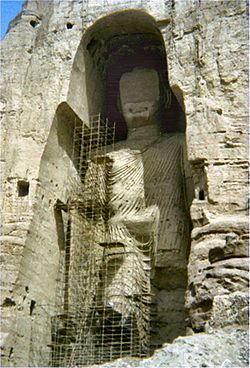Bala Hissar
Experience great views over Kabul by following the ancient city walls leading from Bala Hissar, an ancient fortress, up the mountainside. The fortress was rebuilt in the 19th century after the British army saw that it was all but destroyed it in the Second Anglo-Afghan War.

https://blogger.googleusercontent.com/img/b/R29vZ2xl/AVvXsEgUop_HUagM1DWP8LTEZSs-9gSzaupG3_9TfcCaH3uebFwyRUbMKwRd8681_YZwIis0-eHrTgUULeSgmXKYuzyqJ4UlYPt3w-KE5yCySYU5-SE9M19KxphnYVUzq8LAX9HEpwkKl8aQsIUH/s1600/bala+hissar.JPG
http://upload.wikimedia.org/wikipedia/commons/thumb/5/53/Afghanistan_Statua_di_Budda_1.jpg/250px-Afghanistan_Statua_di_Budda_1.jpg
http://www.livius.org/a/1/alexander/hindu_kush.jpg
http://www.kabulguide.net/kbl-photostory-kabulmuseum_files/image002.jpg

Bamiyan
Visit Bamiyan, the main town near the Hindu Kush. The second- to fifth-century Great Buddhas were destroyed here to international outcry in 2001.


Hindu Kush
Marvel at the Hindu Kush, a wild and remote region consisting of two huge mountain ranges. Although travelling by car is possible, the steepness of the routes makes vehicles prone to breakdowns. For those who make the journey, the mountains, valleys and lakes provide stunning scenery.


Kabul Museum
Though the museum's contents have been dramatically depleted over the years, there is still a good amount of artefacts on display, including Graeco-Bactrian Buddha statues, and a marble basin from Kandhar often referred to as Buddha's Begging Bowl.


https://blogger.googleusercontent.com/img/b/R29vZ2xl/AVvXsEgUop_HUagM1DWP8LTEZSs-9gSzaupG3_9TfcCaH3uebFwyRUbMKwRd8681_YZwIis0-eHrTgUULeSgmXKYuzyqJ4UlYPt3w-KE5yCySYU5-SE9M19KxphnYVUzq8LAX9HEpwkKl8aQsIUH/s1600/bala+hissar.JPG
http://upload.wikimedia.org/wikipedia/commons/thumb/5/53/Afghanistan_Statua_di_Budda_1.jpg/250px-Afghanistan_Statua_di_Budda_1.jpg
http://www.livius.org/a/1/alexander/hindu_kush.jpg
http://www.kabulguide.net/kbl-photostory-kabulmuseum_files/image002.jpg





